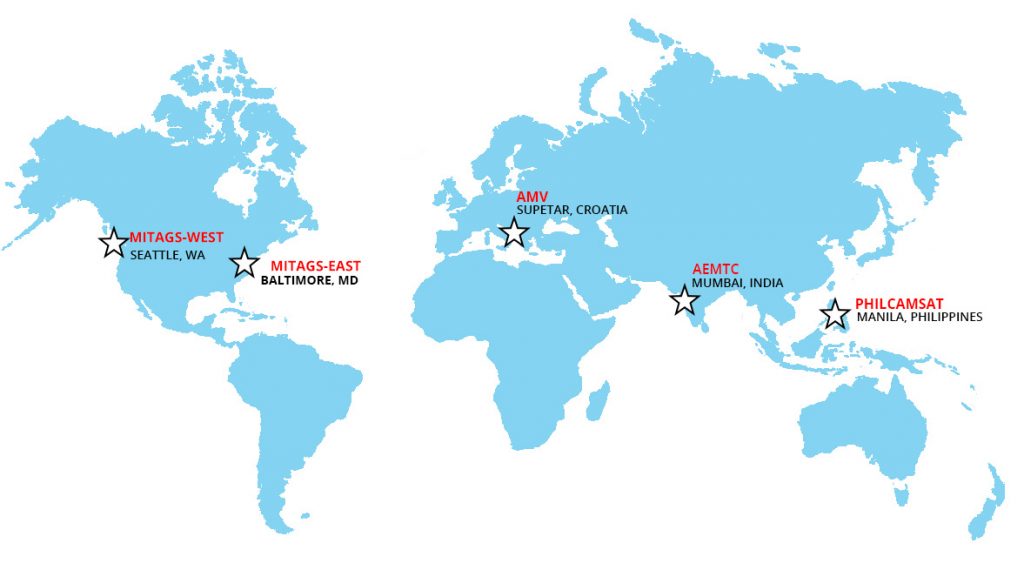Navigation Skills Assessment Program (NSAP)®

The NSAP® is Offered Worldwide
As a result of global demand for an objective tool in risk mitigation, MITAGS has implemented the NSAP® at various International Training Centers (ITC) throughout the world.
The NSAP® is a risk-based measurement and reporting tool developed by MITAGS. It objectively assesses mariners’ competency, focusing specifically on the core skills required of licensed deck officers as defined by international standards (STCW) and industry best practices.
NSAP® is designed to reduce catastrophic maritime incidents by evaluating mariners’ proficiency, knowledge and use of technology. At the conclusion of the NSAP® session employers receive a comprehensive report which identifies the participant’s specific strengths and areas requiring improvement. Many companies use this report to guide future allocation of training resources to improve specific skills or mitigate specific risks.
What Is the NSAP®?
The Navigation Skills Assessment Program (NSAP)® is a risk-based measurement tool that evaluates a mariner’s performance against a scenario delivered in a maritime simulator. The assessment focuses on the core skills required of licensed deck officers as defined by international standards and industry best practices.
Each NSAP® session uses realistic scenario-based exercises geared toward ship operations in congested waters, overlaid by several critical tasks or emergencies. Subject Matter Expert Assessors are present throughout to evaluate the assessment based on pre-established criteria. At the conclusion of the session, the Assessor debriefs the participant, providing an opportunity to discuss individual performance and possible areas for improvement to enhance navigational skills.
NSAP® Standards
The NSAP® assessment criteria have been developed in consultation with expert psychometricians to measure mariner performance against the highest standards in the industry.
The starting point of assessment are the minimum standards of competence outlined in Standards of Training, Certification, and Watchkeeping (STCW) Table A-II/1 and A-II/3. The scenario then incorporates real-time challenges mariners encounter at sea, including:
- Using Aids to navigation.
- Bridge Resource Management.
- Communication.
- Managing tide and current.
- Shiphandling.
- Navigational dangers including shoal waters.
- Areas of high traffic density.
- Correct application of the Rules of the Road.
- Vessel Traffic Systems.
- Variable weather conditions including restricted visibility.
These challenges are integrated into the appropriate regulatory framework of navigation rules, shipboard management systems and company policies and procedures. With the addition of each layer, Subject Matter Experts evaluate the realism and feasibility of the challenges created. By creating the scenario element by element, the developers build a challenging assessment that remains within a competent mariner’s capabilities.
The Benefits of the NSAP®
NSAP® allows deck officers to improve their skills and assists companies in determining where their crew members have room to grow. The assessment offers benefits to organizations and individuals, including:
- Assesses skills: Assessments that are developed to the highest standards and reviewed by leading experts in the industry. After an assessment, the raw data is analyzed to produce reports that provide results based on participants’ backgrounds and other statistics. Using this information, organizations can compare their employees’ skills.
- Identifies skill gaps: The results of the NSAP® allow organizations and individuals to detect skill gaps, either across a group of deck officers or in a single person. With knowledge of those skill gaps, organizations can provide additional training or work with individuals to improve their knowledge and skill.
- Improves maritime safety: The NSAP® aims to improve maritime safety through risk assessment and mitigation. The skills assessment provides companies with a means for evaluating risk and taking proactive measures to protect crew members and other vessels on the sea.
- Simulates real situations: The NSAP® is a simulation, but it’s designed to closely mimic real-life situations and scenarios. The scenarios available allow you to get a realistic sense of how your crew members would respond and react in a particular circumstance.
- Debriefing opportunity: At the end of the assessment, the participant and assessor debrief, which provides participants with an opportunity to learn and grow based on their performance in the scenario.
- Multiple scenarios available: Various NSAP® scenarios are available to meet your organization’s needs. Your company can use the assessments to determine who to hire or to evaluate the skills of management or operational-level deck officers.
Which NSAP® do you Need?
Primarily Management Level Deck Officers operating Deep Draft Vessels on Ocean Routes subject to the Standards of Training, Certification, and Watchkeeping (STCW).
NSAP® Oceans – Operational Level
Primarily for Operational Level Deck Officers operating Deep Draft Vessels on Ocean Routes subject to the Standards of Training, Certification, and Watchkeeping (STCW)
NSAP® Workboat
Primarily for Deck Officers operating vessels of a tonnage less than 3000 ITC operating on Routes subject to the Standards of Training, Certification, and Watchkeeping (STCW)
NSAP® River
Primarily for Deck Officers operating vessels of a tonnage less than 3000 ITC operating on Routes generally not subject to the Standards of Training, Certification, and Watchkeeping (STCW)
NSAP® New Hire
Primarily utilized to assist companies in the hiring process. The NSAP® new hire is sometimes used by companies or organizations in combination with an internally devised and set ‘cut-score’ to align to its organizational values in addition to the NSAP®-set highest standards and industry best practices.
View the NSAP® Brochure!
NSAPWhat People Are Saying About NSAP®
Feedback about NSAP® has been highly positive. Read what some captains and industry leaders said about the assessment:
